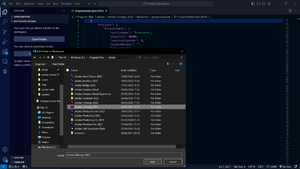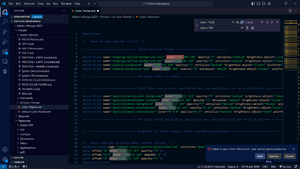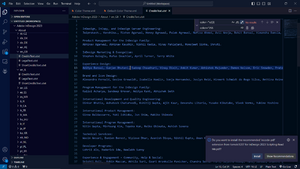User:Ssstephen/Reading/awkwardgestures
https://freeze.sh/_/2008/awkward/awkward_gestures.mdsh
Although a streamlined process might be faster, it runs the risk of everything looking the same in the end. Thus, in order to make your mark, a diversification of tools is necessary.
What's wrong with everything looking the same? Does design need to be different? Maybe if most designers keep using adobe tools then most designed objects will continue to be boring, and people will gradually be less affected by design. Accellerationist boring predictable design. Make more crap until no one listens at all. Reuse the same poster from a different event last year. Make another spiderman movie. Release New Coke again. Switch back to the original recipe again. Make all the new property developments look exactly the same and vote for whoever is already in charge.
software does not merely determine the boundaries of visual expression. Because it is constantly present, it conditions our practice in terms of division of labour, vocabulary and the physical relationship with the digital medium.
This is of course much more interesting.
OSP is first of all an attempt to facilitate a design practice that starts from a critical use of technology and explicitly functions in an ecology of knowledge based on distribution and circulation rather than competition and exclusion.
And this. But still I wonder if being critical of technology is the best focus. It seems to me more a useful lens for critique of labour conditions more generally. Does the software really limit division of labour? Is there for example a real world where one designer has InDesign installed and one illustrator has Illustrator installed, and they only interact through adobe standards and the creative cloud? More realistic to me are the jewellery designer who makes her own ads in Canva and the sound engineer who learnt Premiere Pro to survive through the pandemic.
William Morris's Arts and Crafts movement […] reflected upon the influence of the production process on the nature and meaning of everyday objects. For them, getting the job right implied not only the economic ownership of machines and resources, but also the technical mastery of the work instead of being the machine’s slave.
Again the idea that people are slaves to machines is a bit missing the mark for me. If you feel like a slave definitely warning signals maybe see if there is a rich white man nearby and pay close attention to what he is doing.
But while a computer programmer, by having the right to adjust software, can feel in control, every other ‘power user’ with the same rights, is practically blown away by the explosion of procedures, formats and processes she is confronted with.
Yes totally. Interview between OSP and Dmitri Kleiner.
“It is not this or that… machine which we want to get rid of, but the great intangible machine of commercial tyranny which oppresses the lives of all of us.” William Morris. Art and Its Producers, and The Arts and Crafts of To-day: Two Addresses Delivered Before the National Association for the Advancement of Art. Longmans & Co., London, 1901.
I guess this might be where Colm got his thesis title from.
a clever use of software is often wrongfully considered as craftsmanship
John Maeda, Design by Numbers. I disagree, of course software can be your tool (and you can be good at it (and you can make cool things as an amateur (and not everything needs to be perfect))). You dont need to be a piano builder to be a pianist. It's definitely my approach and obviously the approach that this article is encouraging, but a bit dismissive of other people's practices to say this is the only way to be good at your craft. What if my material as a musician is not the physical piano but the rhythms it can make or the audience or the repetoire or my own sanity. Or at very least, even if intimate knowledge of the tools is essential, that would prove to me that all these other things are just a essential.
we need to avoid a tunnel vision of technology where practices, conditions and perspectives can and must be pushed aside to enable a sense of control.#
Through cutting a comfortably coherent slice out of the unruly entity that software is, you might miss the opportunity to engage with it in other ways than as a means to an end. Software is source code, but also an interface which, whether graphic or not, represents a particular interaction with the underlying processes. Groups of users gather around certain applications and thereby create patterns of use that make sense of this interaction. Mailing lists and documentation on software are characterized by a specific language and tone, as is the way software developers converse with each other and their users. When we consider software as culture, it is perhaps possible to drop the rhetoric of master and slave, and we can begin to think about how ‘competence’ can mean more than ‘control’.
<3
Adobe makes every effort to push the simulations and algorithms, the monstrous machinery, that define the software, into the background.
I mean its still software installed on my computer.
Some of the files for sure look like gibberish but that would happen if I looked at an open source program too. I get that I'm only editing some presets, but I'm kinda curious to see how customisable this tool is. Is that really the issue here.
© 1999-2023 Adobe. All rights reserved. Adobe, the Adobe logo, InDesign, and InCopy are either registered trademarks or trademarks of Adobe Inc. in the United States and/or other countries. PANTONE® Colors displayed here may not match PANTONE-identified standards. Consult current PANTONE Color Publications for accurate color. PANTONE® and other Pantone LLC. trademarks are the property of Pantone LLC. © Pantone LLC., 2010. TOYO COLOR FINDER® SYSTEM AND SOFTWARE © TOYO INK MFG. CO., LTD. 1991-1994. Color Database derived from Sample Books © Dainippon Ink and Chemicals, Inc., licensed to Adobe Inc. This product includes software developed by the Apache Software Foundation (http:www.apache.org/). ODFRC © 1991-6 Apple, Inc., Portions of this program written with MacAPP®, © 1985-1988 Apple, Inc., Portions Copyright 1998, Hutchings Software. Portions utilize Microsoft Windows Media Technologies. Copyright 1999-2002 Microsoft Corporation. All rights reserved. MPEG Layer-3 audio compression technology licensed by Fraunhofer IIS and THOMSON multimedia. Certain trademarks are owned by The Proximity Division of Franklin Electronic Publishers, Inc., and are used by permission. Merriam-Webster is a trademark of Merriam-Webster, Inc. Portions copyright © Chris Maunder, 1998. Updated Information/Additional Third Party Code Information available at http://www.adobe.com/go/thirdparty/
https://www.wur.nl/en/article/what-does-all-rights-reserved-mean.htm
Legal exceptions to this include private use and the right to quote from a work.
Is modifying software for your own use in breach of copyright? Is posting screenshots of Adobe code on the internet in breach of copyright?
“A sane person”, says Zeno, “doesn’t analyse himself, doesn’t look in the mirror”
it is important that imperfections remain visible so that users feel inspired to report them or do something about them.
Some people feel responsible to make imperfections visible? Others feel overwhelmed by the imperfections everywhere.
The obligatory use of open standards is the last but not least reason for processes being more explicit in FLOSS. Far from being normalised, they often cause obstructions in the publishing workflow where documents are sent back and forth between authors, designers and printers. The risk of a possible incompatibility compels us to warn, to explain and to be alert during each moment of the process. Conversions are never flawless.
Conversions are never flawless.
Taking doubt into account implies breaking with the natural ‘flow’ of things and accepting the hitches that aren’t always that easy to deal with. It is in this way we have started to understand the importance of performing our practice publicly because it brings out unusual gestures that break with the appeasing elegance of the typical self-assured designer who has everything sorted.
Designers are infallible creative geniuses and their machines are crappy evil glitchy broken? Or breaking the software helps to see the broken humans behind it?
While a familiar gesture is one that fits perfectly well in a generally accepted model, an awkward gesture is a movement that is not completely synchronic. It’s not a countermovement, nor a break from the norm; it doesn’t exist outside of the pattern, nor completely in it. Like a moiré effect reveals the presence of a grid, awkward behaviour can lead to a state of increased awareness; a form of productive insecurity that presents us with openings that help understand the complex interaction between skills, tools and medium.
Throughout our practice we are looking for forms of reflection that can do without comfortable distance. We use our awkwardness as a strategy to cause interference, to create pivotal moments between falling and moving, an awkward in-between that makes space for thinking without stopping us to act.



